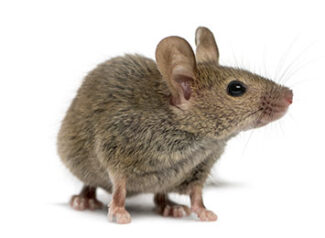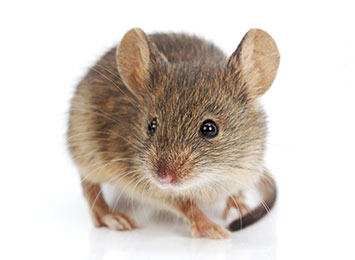Size: On average no longer than 4 inches in length, and no more than 1.5 oz. in weight.
Color: Brown, black, white, gray, and combinations thereof.

Size: On average no longer than 4 inches in length, and no more than 1.5 oz. in weight.
Color: Brown, black, white, gray, and combinations thereof.

First and foremost, mice leave behind small, cone-shaped or round brown droppings everywhere they go. These droppings may stain the floor or walls. Mouse urine also smells and leaves stains on carpeting.
Mice never stop teething. To keep their teeth sharp, they have to constantly chew on something. They’ll chew on cardboard, plastic, electrical wiring, wood, and paper. This can result in holes in walls, damaged electronics and messes in storage areas like closets or basements.
There are many ways to discover mice in NYC homes or businesses. These signs are similar to those for rat infestations and include:
If you notice any of these signs, it’s time to call in professional mice control. NYC residents can count on Assured Environments to quickly and effectively solve their mouse problem.
Scientific Order: Rodentia
Family: Muridae
Common Species:
House mouse (mus musculus)
White-footed mouse (Peromyscus leucopus)
Deer mouse (Peromyscus maniculatus)
Mice are adept at squeezing through small cracks and gaps to access buildings. They can even fit through any opening the size of a dime! They find these gaps by following the smell of food and air currents created by warm drafts on cold days.
The first step in getting rid of mice in NYC is to look for gaps and cracks where mice are entering your home or business. Common points of entry include:
Patch up these openings with caulk or steel wool and repair any screens with holes in them.
Mice are always in search of their next meal. Keep any food products stored and sealed to prevent mice from smelling them. A clean kitchen and pantry deters mice from thinking twice about making an extended stay.
For additional help preventing and getting rid of mice, NYC residents can call Assured Environments for custom solutions to your unique situation.
Mice are nocturnal creatures and are shy around humans. You’re more likely to see the signs of mice than an actual mouse. You may hear scratching, rustling or squeaking in your walls in the evening and see evidence of their activity during the day.
Mice are mainly herbivores, meaning that they prefer eating plants, fruits, and grains. When mice move into a home or business, they adapt quickly and become opportune eaters. They are nibblers that may eat 20+ times a day and will eat nearly anything they can find. They may also chew on your furniture, clothing and electric cords.
Mice prefer not to forage more than 25 feet for their food and tend to nest close to a reliable food source. When controlling mice, set traps and baits in areas where you know of activity to maximize results.
Female mice 4 months or older can have up to 15 litters per year, each with an average of 6-12 babies. Upon giving birth, mice can become pregnant again within a single day. As a result, NYC mice populations grow very rapidly once a mating pair establishes itself. Because mice reproduce so quickly, strong pest control measures are recommended to keep the population in check.
Mouse pups are born blind and without fur or ears but rapidly reach full sexual maturity at five weeks old. Most mice live less than one year in the wild, but in protected environments such as buildings and your home, they can live for two to three years.

Deer Mice
Deer mice, also called field mice, are a heartier species of mouse that tends to prefer life outside. They live in fields and forests and can survive winter’s colder temperatures.
Identify deer mice by their gray or reddish-brown bodies and white bellies. They often have white feet as well. Their faces end in a pointed nose and they have dark beady eyes and larger ears. Deer mice also have long whiskers and longer, hair covered, tails.

House Mice
House mice are the most likely species of New York mice you’ll encounter. They are smaller than deer mice with rounded ears and uniform body color – usually gray, black or brown without the white belly. Their tails are long, thin and hairless.
House mice have softer fur and were bred to become the domesticated or fancy mice you find at a pet store.
Solving your NYC mouse problem can be challenging because mice are small, intelligent and prolific.
Bait Traps:
Most people think that laying traps baited with poison will eradicate a population of mice. However, mice are instinctively cautious and will experience “bait shyness” after ingesting a tiny bit of poison. Because this small bite of poison does not kill them but only makes them sick, they now know to avoid the bait — and the trap.
Ultrasonic Mice Repellent Devices:
These devices do not work because mice quickly become accustomed to unfamiliar noises and soon ignore repeated “beeps” that humans can’t hear. In addition, these devices are directional, so the sounds can’t penetrate solid objects and tend to lose their intensity with distance. In fact, no scientific evidence exists that shows vibratory, auditory or magnetic devices will send mice, rats or any other creature fleeing from a building.
Mouse Exterminator, NYC
If you’re experiencing a mouse infestation, a professional pest control expert is your best solution. Assured Environments can create an effective plan for eliminating mice and identify how they got in to prevent future infestation.
If you experience a mouse infestation, a professional pest control expert can create an effective plan for eliminating them.
New York State Department of Health Mouse Control fact sheet
Illinois Department of Public Health House Mouse Prevention & Control fact sheet
National Pesticide Information Center mice fact sheet
The primary difference between rats vs mice is their size. While mice are modest in size, typically growing no more than 4 inches, rats average 6-8 inches in length. Rats also have long tails that are often longer than their bodies. Rat tails tend to be thicker and scaley while mouse tails are thin and smooth. Another distinction is the difference between rat droppings vs mouse droppings. Rat droppings are 1⁄2-3/4” long, shiny and black. Mouse droppings are smaller and smooth with pointed ends.
Yes. Mice can easily squeeze under doors and through narrow cracks. That’s why it’s important to fill these gaps in your home, especially in fall when pests seek shelter from colder temperatures. The best way to stop mice from getting under your door is to add weather stripping or to install a door sweep.
Mice have been known to squeeze through a ¼” hole. That’s about the size of a dime. Mice are also capable of chewing smaller holes open to gain access. Caulk any gaps you find along your exterior walls to keep mice from getting in.
Absolutely. Mice can climb stairs and much more. They are accomplished climbers that can scale the sides of homes or use trees or shrubs to gain access to upper level windows. Don’t discount the ninja-like power of a tiny mouse!
Mice are surprisingly adept jumpers that can clear distances as high as one foot. This spring-like ability helps them get into food containers and other areas where you might not expect them.
Mouse urine isn’t different from that of other animals. Stains will appear dry, crusty and yellow, amber or brown. Clean stains as you discover them to prevent the spread of disease.
According to the CDC, mice carry a number of diseases and maladies. A study from 2018 showed that NYC mice in particular spread a variety of bacteria and viruses.